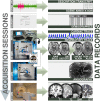A high-resolution 7-Tesla fMRI dataset from complex natural stimulation with an audio movie
- PMID: 25977761
- PMCID: PMC4322572
- DOI: 10.1038/sdata.2014.3
A high-resolution 7-Tesla fMRI dataset from complex natural stimulation with an audio movie
Abstract
Here we present a high-resolution functional magnetic resonance (fMRI) dataset - 20 participants recorded at high field strength (7 Tesla) during prolonged stimulation with an auditory feature film ("Forrest Gump"). In addition, a comprehensive set of auxiliary data (T1w, T2w, DTI, susceptibility-weighted image, angiography) as well as measurements to assess technical and physiological noise components have been acquired. An initial analysis confirms that these data can be used to study common and idiosyncratic brain response patterns to complex auditory stimulation. Among the potential uses of this dataset are the study of auditory attention and cognition, language and music perception, and social perception. The auxiliary measurements enable a large variety of additional analysis strategies that relate functional response patterns to structural properties of the brain. Alongside the acquired data, we provide source code and detailed information on all employed procedures - from stimulus creation to data analysis. In order to facilitate replicative and derived works, only free and open-source software was utilized.
Conflict of interest statement
The authors declare no competing financial interests.
Figures





References
Data Citations
References
-
- Berg D., Boehnke S., Marino R., Munoz D. & Itti L. Free viewing of dynamic stimuli by humans and monkeys. J. Vision 9 (2009). - PubMed
-
- Itti L. & Koch C. Computational modeling of visual attention. Nat. Rev. Neurosci. 2, 194–203 (2001). - PubMed
-
- Dorr M., Martinetz T., Gegenfurtner K. & Barth E. Variability of eye movements when viewing dynamic natural scenes. J. Vision 10, 28 (2010). - PubMed
Publication types
MeSH terms
LinkOut - more resources
Full Text Sources
Other Literature Sources
Medical

